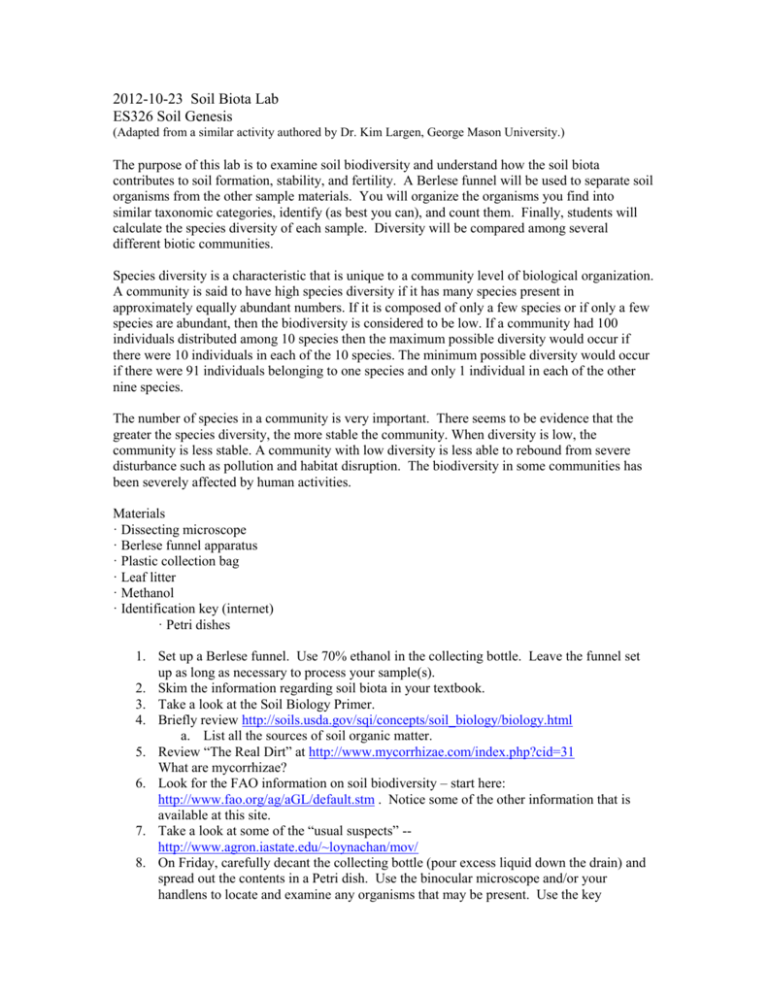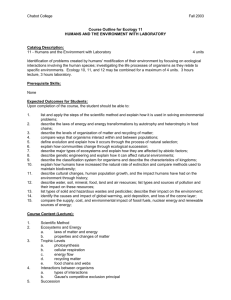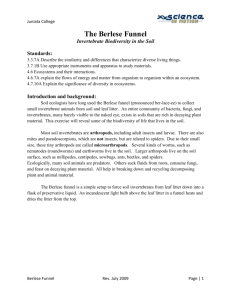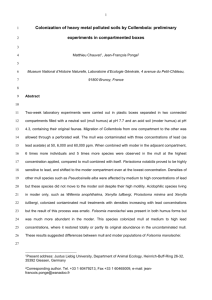2007-12-05 Soil Biota
advertisement

2012-10-23 Soil Biota Lab ES326 Soil Genesis (Adapted from a similar activity authored by Dr. Kim Largen, George Mason University.) The purpose of this lab is to examine soil biodiversity and understand how the soil biota contributes to soil formation, stability, and fertility. A Berlese funnel will be used to separate soil organisms from the other sample materials. You will organize the organisms you find into similar taxonomic categories, identify (as best you can), and count them. Finally, students will calculate the species diversity of each sample. Diversity will be compared among several different biotic communities. Species diversity is a characteristic that is unique to a community level of biological organization. A community is said to have high species diversity if it has many species present in approximately equally abundant numbers. If it is composed of only a few species or if only a few species are abundant, then the biodiversity is considered to be low. If a community had 100 individuals distributed among 10 species then the maximum possible diversity would occur if there were 10 individuals in each of the 10 species. The minimum possible diversity would occur if there were 91 individuals belonging to one species and only 1 individual in each of the other nine species. The number of species in a community is very important. There seems to be evidence that the greater the species diversity, the more stable the community. When diversity is low, the community is less stable. A community with low diversity is less able to rebound from severe disturbance such as pollution and habitat disruption. The biodiversity in some communities has been severely affected by human activities. Materials · Dissecting microscope · Berlese funnel apparatus · Plastic collection bag · Leaf litter · Methanol · Identification key (internet) · Petri dishes 1. Set up a Berlese funnel. Use 70% ethanol in the collecting bottle. Leave the funnel set up as long as necessary to process your sample(s). 2. Skim the information regarding soil biota in your textbook. 3. Take a look at the Soil Biology Primer. 4. Briefly review http://soils.usda.gov/sqi/concepts/soil_biology/biology.html a. List all the sources of soil organic matter. 5. Review “The Real Dirt” at http://www.mycorrhizae.com/index.php?cid=31 What are mycorrhizae? 6. Look for the FAO information on soil biodiversity – start here: http://www.fao.org/ag/aGL/default.stm . Notice some of the other information that is available at this site. 7. Take a look at some of the “usual suspects” -http://www.agron.iastate.edu/~loynachan/mov/ 8. On Friday, carefully decant the collecting bottle (pour excess liquid down the drain) and spread out the contents in a Petri dish. Use the binocular microscope and/or your handlens to locate and examine any organisms that may be present. Use the key (http://www.cals.ncsu.edu/course/ent591k/kwikey1.html) to identify the organisms. This is a binomial key, much like the one used in the USDA Soil Taxonomy system. 9. Make a table with the scientific and common names of the organisms you found, and the number of each that you counted. If you find an organism that you cannot identify, give it a letter (A, B, and so on) to distinguish it from other organisms. You may need to group organisms into higher taxonomic classifications, above the species level. 10. Determine the relative abundance of each individual species and record in Table 1 (you determined the absolute abundance of each species by counting the number of individuals of each different species). Relative abundance compares the number of organisms of a particular species with the total number of organisms found in the sample. Relative abundance of a species in a sample is calculated by dividing the number of individuals of that species by the total number of individuals in the entire sample. An example calculation follows: Relative abundance = ni / N ni = actual number of individuals of species i N = the total number of individuals of all types collected in sample Example data and calculations for relative abundance, with 3 species and total number of individuals (N) = 85: Species (i) 1 2 3 Absolute Abundance (ni) 50 25 10 Relative Abundance (pi) 50/85 = 0.588 25/85 = 0.294 10/85 = 0.118 Determine the diversity of your sample using Simpson’s Index of Diversity and record in the table on the chalkboard. The following example illustrates how to calculate Simpson's Index of Diversity: Ds = 1 - (Σni(ni-1) / N(N-1)) Ds values closer to 0 = low diversity Ds values closer to 1 = greater diversity








